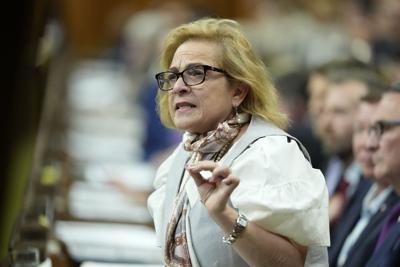A TikTok video claimed refugees receive $82,000 in tax-free benefits per year from the federal government, while the average ºÚÁϳԹÏÍø receives only $63,000. This claim is misleading. The cost breakdown includes temporary accommodation that refugees receive upon arrival in Canada, but the scenario in which this would reach $82,000 is unlikely. While refugees receive income support through the federal Resettlement Assistance Plan, such assistance is temporary and does not amount to $82,000 annually.Ìý
THE CLAIM
"You know you can get up to $82,000 ºÚÁϳԹÏÍø dollars from ºÚÁϳԹÏÍø government for doing nothing?" asks a TikTok user with more than 130,000 plays.Ìý
According to the video, refugees in Canada receive $224 per day from the federal government, including $140 for accommodation and $84 for food.Ìý
The video makes the comparison between the supposed $82,000 refugees receive annually and what it claims is the average ºÚÁϳԹÏÍø income of $63,000 to highlight the disparity between a refugee versus ºÚÁϳԹÏÍø citizen's annual income.Ìý
The claim made its way to other social media, including the , formerly Twitter, and .Ìý
RATING: Misleading
Refugees in Canada receive assistance through the federal (RAP) administered by Immigration, Refugees and Citizenship Canada (IRCC). Â
However, the monetary support they receive during their temporary accommodations after arriving in Canada doesn't go directly into their bank accounts and in most cases would not reflect $82,000 annually.Ìý
According to a from the immigration minister's office to MP Lianne Rood, refugee claimants in IRCC-operated hotels are provided with accommodations and meals once relocated, regardless of how they entered Canada.Ìý
The average cost per room was $140 per night per room and $84 per day per claimant, based on January 2024 rates. Added together, the cost amounts to $224.Ìý
However, the $140 applies to hotel rooms, not individuals. Rooms may house several refugees at once — a family, for example — lowering the cost per person.Ìý
The IRCC has set the standard length of stay for temporary accommodations at one to three weeks. However, a 2023 internal dashboard showed "the national average stay in temporary housing ," and "54 per cent of surveyed refugees reported staying for longer than one month," according to an IRCC report released in August 2024.
That means most refugees aren't staying in temporary accommodations long enough to get $82,000 worth of food and housing.Ìý
So what do refugees actually receive?Â
An April fact check from ºÚÁϳԹÏÍø investigating similar misleading claims about refugee support amounts consulted in September 2024 to find the monthly benefit amount an individual or family of refugees could receive.Ìý
There are to the RAP. The first provides short-term funding to service provider organizations, which deliver the temporary accommodations mentioned above, and cover other immediate needs after refugees arrive in Canada.
Once refugees secure permanent housing, they're eligible for direct financial support – including one-time payments and monthly income support – for up to one year, or two years in "exceptional circumstances," or until a refugee can support themselves.
The minimum monthly payment for a single adult in Ontario going by those rates would be around $1,094 per month, while a family of six could receive around $1,700 monthly.Ìý
Exact rates vary by province and families and people with disabilities or maternity needs could receive more.Ìý
The monthly payment includes money for basic needs, shelter, communication and transportation as well as a housing supplement, which maxes out at $200.Ìý
Those monthly benefits typically go directly to the refugee's bank account as a direct deposit, but the average refugee wouldn't receive anywhere near $82,000 per year.Ìý
While RAP assistance isn't taxable, refugees must pay taxes if they earn an income and, as data from Statistics Canada shows, they are in fact among "newly landed immigrants" to file their taxes upon arriving in Canada, at around 95 per cent.Ìý
The average ºÚÁϳԹÏÍø income as of 2023 was , according to Statistics Canada.Ìý
In the , the income of asylum claimants who arrived in Canada between 2011 and 2021 varied from $19,600 to $34,400, according to Statistics Canada.
SOURCES
Claim posted to June 20, 2025 () and to June 21, 2025 () and May 8, 2025 ()
Resettlement Assistance Program (RAP) Service Provider Handbook. Immigration, Refugees and Citizenship Canada via Government of Canada . Accessed July 2, 2025 ()
Reply from immigration minister's office to MP from May 7, 2024 ()
Evaluation of the Refugee Resettlement Program. Immigration, Refugees and Citizenship Canada . August 2024 ()
Marissa Birnie. Posts mislead on refugee support amounts. ºÚÁϳԹÏÍø website. April 24, 2025 ()
Ontario Resettlement Assistance Program (RAP) Rates September 01, 2024. Refugee Sponsorship Training Program . Accessed July 2, 2025 ()
Tahsin Mehdi et al. Tax-filing rates of newly landed immigrants in Canada: Trends and insights. Statistics Canada . Nov. 22, 2023 ()
Income of individuals by age group, sex and income source, Canada, provinces and selected census metropolitan areas. Statistics Canada . May 1, 2025 ()
Income of asylum claimants by claim year and tax year, for Canada and provinces, 2022 constant dollars. Statistics Canada . Dec. 9, 2024 ()
ABOUT CANADIAN PRESS FACT CHECKS
You can find out more about ºÚÁϳԹÏÍø here and about ºÚÁϳԹÏÍø Press Fact Checks here. To reach our fact-checking team with any tips, corrections or comments, please email us at cpfactcheck@thecanadianpress.com.



































